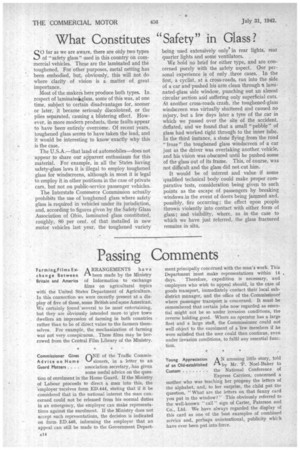What Constitutes "Safety" in Glass ?
Page 16

If you've noticed an error in this article please click here to report it so we can fix it.
QO far as we are aware, there are only two types of "safety glass" used in this country on commercial vehicles. These are the laminated and the toughened. For other purposes, metal netting has been embodied, but, obviously, this will not do where clarity of vision is a matter of great importance.
Most of the makers here produce both types. In respect of laminate4glass, some of this was, at one time, subject to certain disadvantages for, sooner or later, it became seriously discolotred, or the plies separated, causing a blistering effect. However, in more modern products, these faults appear to have been entirely overcome. Of recent years, toughened glass seems to have taken the lead, and it would be interesting to know exactly why this is the case.
The U.S.A.—that land of automobiles—does not appear to share our apparent enthusiasm for this material. For example, in all the States having safety-glass laws it is illegal to employ toughened glass for windscreens, although in most it is legal to employ it in other positions in the case of private cars, but not on public-service passenger vehicles.
The Interstate Commerce Commission actually prohibits the use of 'toughened glass where safety glass is required in vehicles under its jurisdiction, and, according to figures given by the Safety Glass Association of Ohio, laminated glass constituted, roughly, 80 per cent, of that installed in new motor vehicles last year, the toughened variety being used extensively only' in rear lights, rear quarter lights and some ventilators.
We hold no brief for either type, and are concerned purely with the safety aspect. Our personal experience is of only three cases. In the first, a cyclist, at a cross-roads, ran into the side of a car and'pushed his arm clean through a larninated-glass side window, punching out an almost circular section and suffering only superficial cuts. At another cross-roads crash, the toughened-glass windscreen was virtually shattered and caused no injury, but a few days later a tyre of the ,car in which we passed over the site of the accident, deflated, and we found that a small " pebble " of glass had worked right through to the inner tube. In the third instance, a stone flying from the road " froze " the toughened glass windscreen of a car just as the driver was overtaking another, vehicle, and his vision was obscured until he pushed some of the glass out of its frame. This, of course, was not difficult and the glass did not.cut him.
It would be of interest and value if some 'qualified technical body 'could make proper comparative tests, consideration. being given to such points as the escape of passengers by breaking windows in the event of doors being jammed and, possibly, fire occurring ; the effect upon people thrown violently into contact with either form of glass ; and visibility, where, as in the case to which we have just referred, the glass fractured remains in situ.




















































